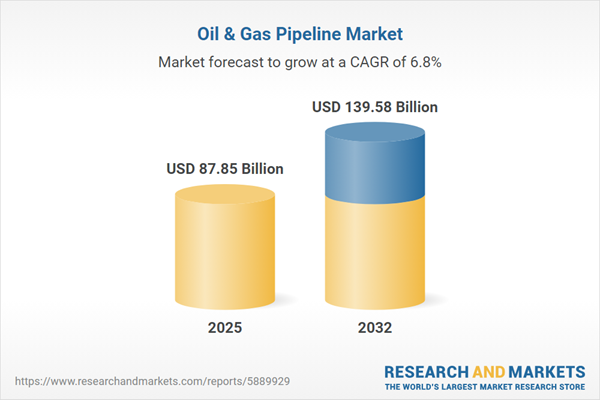Speak directly to the analyst to clarify any post sales queries you may have.
The oil & gas pipeline market is evolving as operators invest in infrastructure optimization, adapt to shifting regulatory frameworks, and address operational complexities. Senior decision-makers are prioritizing efficiency and future-ready resilience to meet changing industry demands.
Market Snapshot: Oil & Gas Pipeline Market Size and Growth
The oil & gas pipeline market is demonstrating consistent expansion, forecast to increase from USD 82.21 billion in 2024 to USD 87.85 billion in 2025, with projections reaching USD 139.58 billion by 2032. This reflects a robust CAGR of 6.84%. Sustained demand for energy, increased capital investment in new and existing pipeline assets, and the acceleration of international energy transit routes are key drivers shaping this trajectory. Major pipeline projects and industry-wide regulatory responses are prompting organizations to adapt strategically, while supply chain fluctuations and compliance pressures influence long-term planning. Senior leadership teams are leveraging these growth patterns for targeted capital deployment and competitive positioning within their portfolios.
Scope & Segmentation of the Oil & Gas Pipeline Market
This analysis encompasses all essential aspects of the oil & gas pipeline sector, offering segmentation to guide strategy, benchmarking, and resource allocation:
- Material Types: Products range from high-density polyethylene, polypropylene, reinforced concrete, to alloy, carbon, and stainless steel, ensuring regulatory compliance and adaptability across applications.
- Fluid Types: Pipelines are engineered to transport crude oil, natural gas, and refined petroleum products for streamlined integration into global and domestic value chains.
- Transportation Methods: Major systems include distribution, flowline, gathering, and transmission pipeline networks designed to optimize delivery from extraction sites to end users and infrastructure hubs.
- Pipe Types: Seamless, electric resistance welded (ERW), longitudinal submerged arc welded (LSAW), and spiral submerged arc welded (SSAW) pipelines address varying technical and geographic requirements.
- Diameters: Categories by up to 16 inches, 16–24 inches, and above 24 inches allow for appropriate throughput and installation strategies specific to project scope.
- Pressure Classes: High, medium, and low pressure classifications prioritize safety and reliable commodity transfer across different regional and operational contexts.
- Coating Types: Enhanced pipeline protection is achieved through fusion bonded epoxy, polyethylene, and reinforced concrete coatings, aligning with environmental goals and asset longevity.
- End Uses: Integration across offshore and onshore environments, with technical solutions tailored to the requirements of each project setting.
- Regions: Comprehensive market scope includes the Americas (US, Canada, Mexico, Brazil), Europe (UK, Germany, Russia, Italy), Middle East (UAE, Saudi Arabia, Qatar), Africa (South Africa, Nigeria, Egypt), and Asia-Pacific (China, India, Japan, Australia, South Korea).
- Notable Companies: Industry leaders such as Enbridge Inc., Enterprise Products Partners L.P., Kinder Morgan, TC Energy Corporation, and The Williams Companies play key roles in setting standards and advancing sector innovation.
Key Takeaways for Strategic Decision-Makers
- Digital innovations, including digital twins and sensor networks, are driving advancements in asset management and predictive maintenance for enhanced operational reliability.
- Material science developments—such as advanced coatings and modern composites—contribute to stronger risk mitigation and adherence to updated environmental mandates.
- Infrastructure modernization in established markets targets performance improvements, while emerging regions focus on leveraging new pipelines to strengthen energy independence and supply capability.
- Collaboration between manufacturers, technology providers, and service organizations is delivering more integrated project management and robust lifecycle asset monitoring practices.
- Proactive project planning and supply chain flexibility are key to managing the impact of regulatory adjustments and dynamic market conditions.
Tariff Impact: US Measures Affecting the Supply Chain
Recent US tariffs on select steel grades have prompted firms to revisit their sourcing and supplier strategies within the oil & gas pipeline supply chain. In response, organizations are expanding domestic procurement, reinforcing local partnerships, and enforcing cost controls to mitigate risks. These adaptive measures allow companies to buffer project timelines and maintain resilience amid ongoing supply disruptions and policy changes.
Methodology & Data Sources
This report draws on interviews with senior executives and technical experts, reinforced by a rigorous review of technical literature and trusted data repositories. Analytical methods include a detailed assessment of manufacturing records, exclusive trade data, and expert commentary to offer actionable guidance tailored for leadership teams.
Why This Report Matters for Industry Leaders
- Enables early identification of market trends, technology shifts, and evolving regulations, supporting faster and better-informed strategic responses.
- Offers segmentation detail and benchmarking to guide investments, project design, and risk mitigation across a range of regional and technical factors.
- Equips stakeholders to address challenges and opportunities linked to new supply chain dynamics and compliance requirements, reinforcing operational resilience.
Conclusion
This analysis provides actionable insights and comprehensive segmentation to empower investment planning and proactive risk management in a challenging oil & gas pipeline market environment.
Additional Product Information:
- Purchase of this report includes 1 year online access with quarterly updates.
- This report can be updated on request. Please contact our Customer Experience team using the Ask a Question widget on our website.
Table of Contents
3. Executive Summary
4. Market Overview
7. Cumulative Impact of Artificial Intelligence 2025
List of Figures
Samples

LOADING...
Companies Mentioned
The key companies profiled in this Oil & Gas Pipeline market report include:- Enbridge Inc.
- Enterprise Products Partners L.P.
- Energy Transfer LP
- Kinder Morgan, Inc.
- TC Energy Corporation
- The Williams Companies, Inc.
- ONEOK, Inc.
- Plains All American Pipeline, L.P.
- MPLX LP
- Magellan Midstream Partners, L.P.
Table Information
| Report Attribute | Details |
|---|---|
| No. of Pages | 199 |
| Published | October 2025 |
| Forecast Period | 2025 - 2032 |
| Estimated Market Value ( USD | $ 87.85 Billion |
| Forecasted Market Value ( USD | $ 139.58 Billion |
| Compound Annual Growth Rate | 6.8% |
| Regions Covered | Global |
| No. of Companies Mentioned | 11 |









